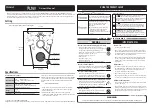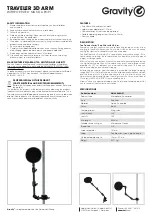
11
PHASE ANGLE MEASUREMENTS
Non-Contact from 69kV and above.
WARNING
See “Product Safety Information”, page 4.
See “Inspection & Maintenance”, page 4.
See “Send Unit Set-up and Testing”, page 8.
See “Receive Unit Set-up and Testing”, page 9.
1.
Attach the Meter Probe to the appropriate length live line tool for the
voltage being tested. Minimum 2 feet
(See Note 1 Pg. 5)
2.
Set the selector switch to the
Deg
position.
3.
Using the meter probe, bring the meter to minimum approach distance as
described in OSHA standard 1910-269, table R-6. You can also use the Bierer
Support Hooks. Use a 2 foot hook for voltages from 69kV to 300kV and use
the 4 foot support hook for voltages above 300kV.
4.
If the conductor is in phase, the Meter Probe should indicate near zero
degrees on the digital display and show a White zero degree indication light.
5.
If the conductors are out of phase, the Meter Probe will indicate either of
the following:
a.
Nominal 120 degrees and a 120 degrees indicator light or
b.
Nominal 240 degrees and a 240 degrees indicator light.
Note:
Delta/ Wye Transformation:
The PD800W provides an additional feature of flagging a Delta Wye
Transformation with a blinking yellow indicator light labeled "DY". Expected
phase angles when phasing a three-phase system are 0 degrees, 120 degrees,
and 240 degrees. The PD800W continuously monitors all phase angles between
the Reference Probe and the Meter Probe when used in either the
Deg, URD,
or
OH
mode. If the phase angle deviates more than +/ - 20 degrees from any of
the three expected values of 0, 120, or 240 degrees the
Yellow
"DY" light will
blink.
WARNING
Unit shall be tested before and after each use on a known voltage source.
Failure to do so could result in false negative indications.
Summary of Contents for Phasing Ranger 2
Page 16: ...16 ...


































